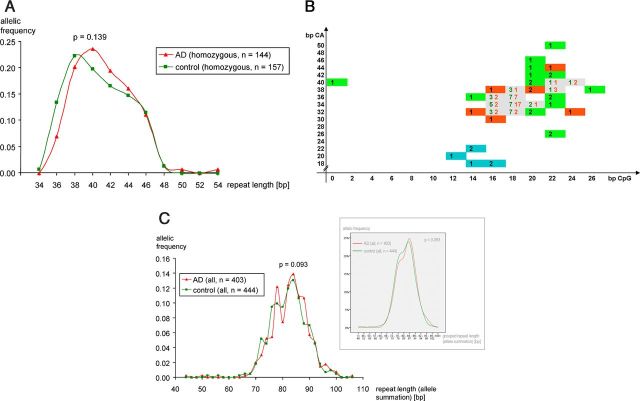Figure 1.
Association of the ECE-1c promoter microsatellite with AD. A, Homozygous (regarding repeat length and not repeat composition) samples of 144 AD patients (red triangles) and 157 control individuals (green rectangles) were genotyped regarding the total length of the ECE-1c promoter microsatellite polymorphism using a fluorescent-labeled genomic PCR spanning the microsatellite repeat. Reaction products were separated on an ABI analyzer. Repeat length denotes the length of the [CG]m–[CA]n repeat itself of one allele, i.e., PCR product length minus length of the flanking region. B, The ECE-1c promoter region of 47 AD patients (red rectangles or red numbers), 58 nondemented controls (comprising 38 controls of the dementia study and 20 individuals of the valsartan study; green rectangles or green numbers) and of 6 chimpanzees (blue rectangles) was subcloned and sequenced to determine the [CpG]m–[CA]n repeat compositions. Abscissa and ordinate indicate the lengths of the CG repeat and CA repeat in base pairs, respectively. The respective genotypings are based on multiple independent clones per individual and multiple sequencing reactions per clone as depicted in Table 3. C, All (i.e., homozygous and heterozygous) samples of 403 AD patients (red triangles) and 404 control individuals (green rectangles) were genotyped regarding the length of the [CG]m–[CA]n repeat within the ECE-1c promoter. Repeat length denotes the summation of the repeat lengths of both homologous chromosomes per individual. The inset represents the identical distributions but with grouped alleles plotted on the abscissa.

